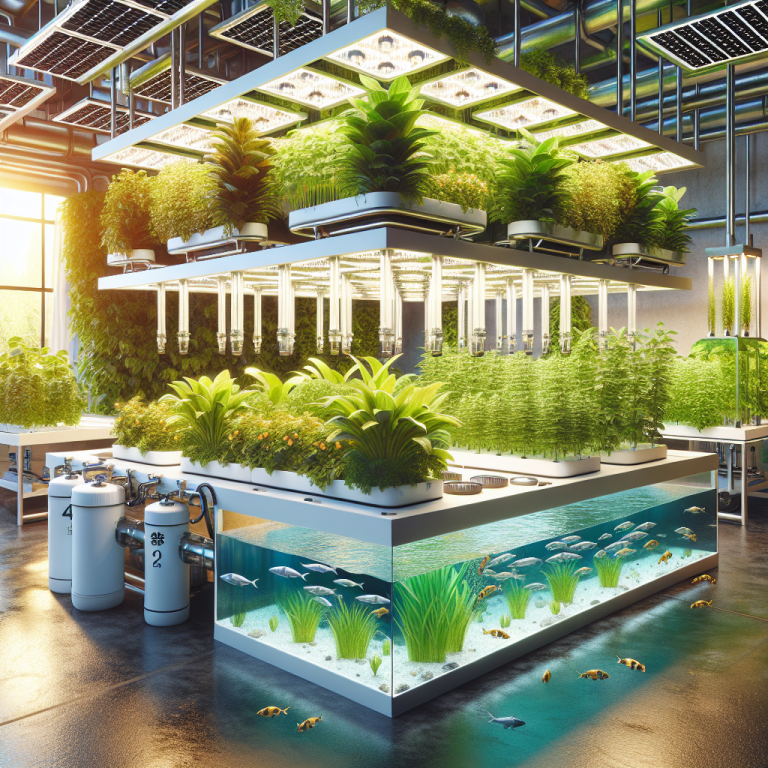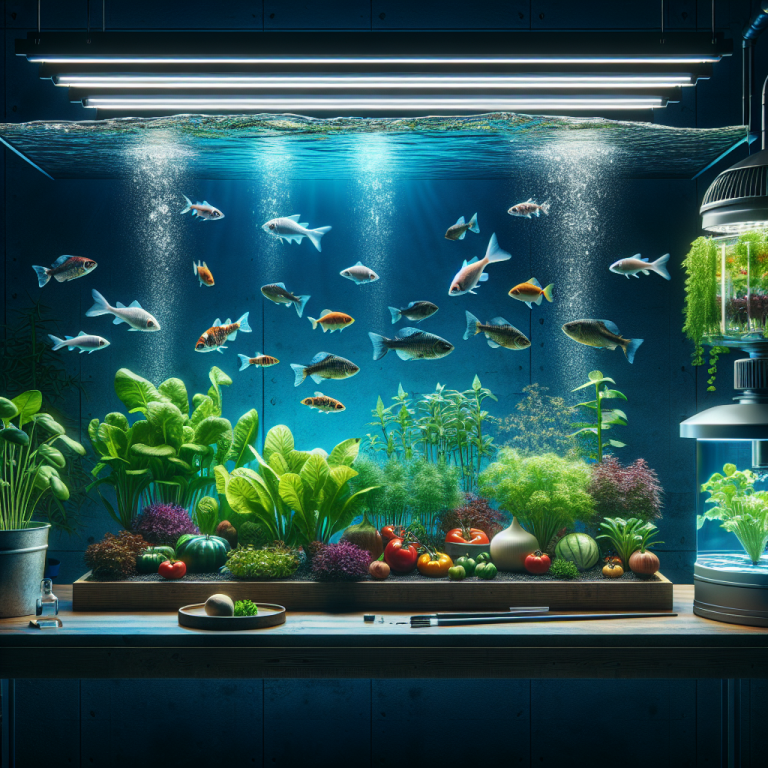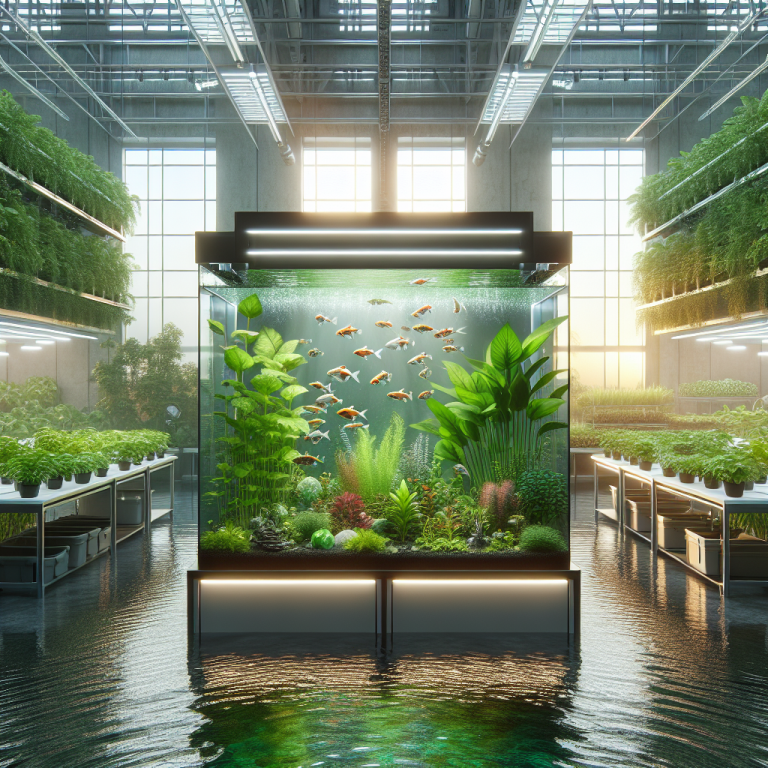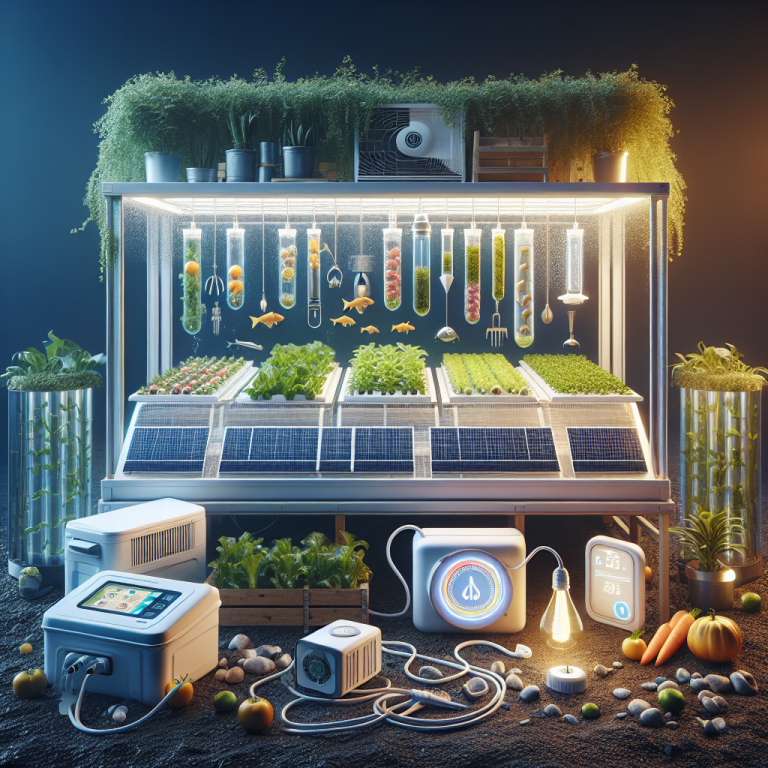Ever puzzled about how you can get your hands dirty and cultivate your very own organic produce? Wonder what's more sustainable than conventional farming? We're glad you've stumbled upon this beginner's guide on "Organic Aquaponics Methods." Doesn't the idea of integrating aquaculture with hydroponics sound a bit intimidating? Relax. Let's assure you that this method, though packed with scientific sounding terms, is definitely within your grasp. Think about the traditional backyard pot planting approach. Now, change the pot soil with water and add some fish to it. You've got yourself a basic structure of an aquaponics system! Of course, it's not that simple to set up and to maintain, no worries, you've landed on the right guide to help you out. Dive in, and explore this riveting world of organic aquaponics. Let's understand its nuts and bolts, from setting up your system to choosing the right fish and plants. We'll journey together through the tips on balancing your mini ecosystem to troubleshooting and, of course, basking in the joy of your harvest. Ready for an adventure into the perpetual cycle of life, with some fish and plants, right at the comfort of your home? Here's to you becoming an amateur urban farmer with organic aquaponics. Let this journey of incessantly learning and growing streamlined by creativity and innovation begin!
Understanding the Basics of Organic Aquaponics Methods
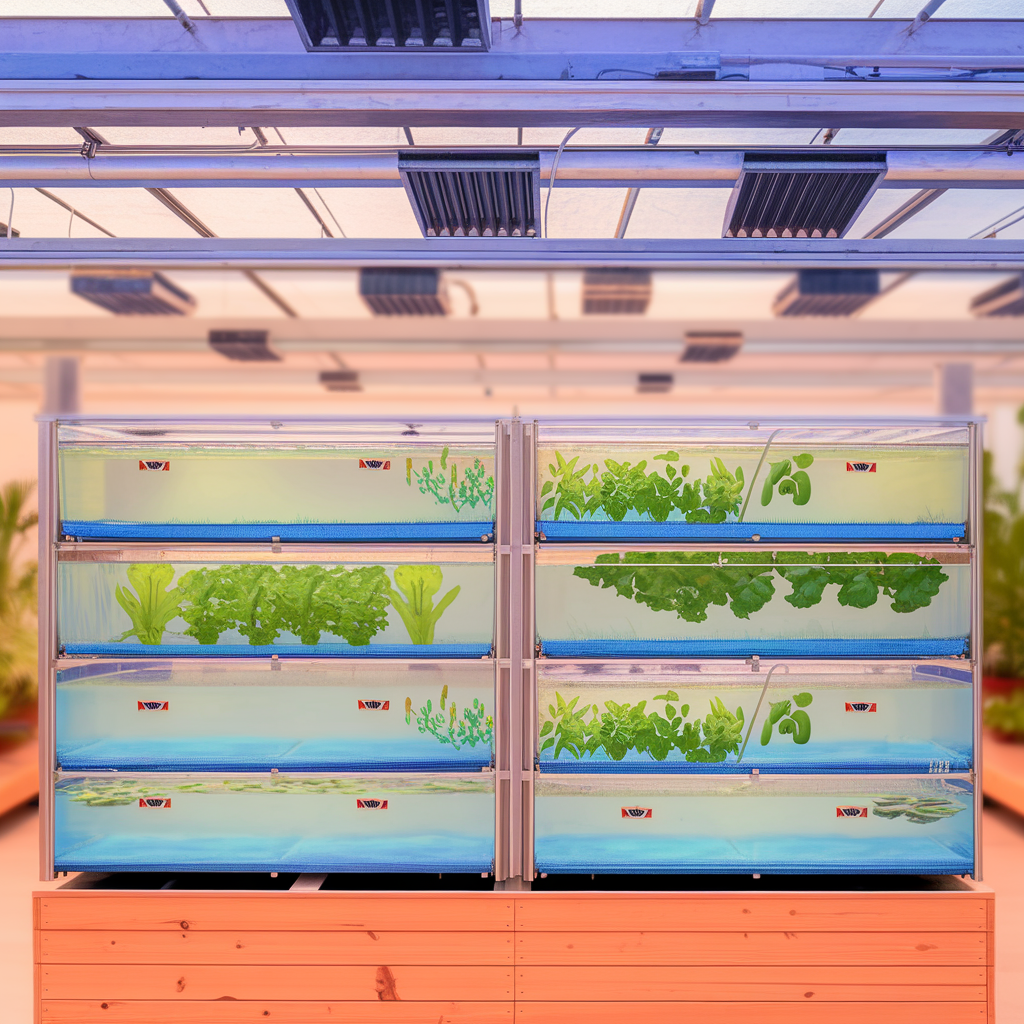
Isn't it exciting to think of growing your own food in your backyard, apartment balcony, or even in a spare room with just the natural ways of organic aquaponics methods? Now, if you just went "Organic whomst?", let's break it down easily. Aquaponics is a sustainable food production system. It combines a traditional aquaculture (raising fish) with hydroponics (soil-less plant growing). The beauty comes when both processes are happily married into a beneficial mutual relationship. The fish waste provides the organic food source for the plants, and in return, plants clean up the water extending life for the fish. It's a win for all. What's "organic" got to do with all this then? Well, the traditional methods of aquaponics may use synthetic nutrients for plant growth acceleration. In our case, we're talking about methods that strictly prohibit the use of synthetic substances. It's all in the name of keeping the substances naturally healthy. So why should I consider this? Simply put, there are numerous benefits to adopting organic aquaponics methods. For starters, it's environmentally friendly. There's less water usage, no harmful chemical release into the environment, and minimal fish wastes to deal with. In our next talking point, let's dive into how you can start with your very own organic aquaponics set-up. It's easier than it sounds, approving nod guaranteed.
Setting Up Your Aquaponics System
Ever dreamed of starting your own aquaponics garden? Let's unravel that dream together. In the cosy realm of organic aquaponics methods, less is more. Such methods keep wellness at the forefront by minimizing chemicals. With that in mind, let's roll up our sleeves and begin. The crux rests on creating the right blend of fish and plants. Round up your plants and fish you want and weave your setup around them. Do some digging — research your choices thoroughly, and find a match that can coexist symbiotically. For instance, lettuces thrive with tilapias. Next, grab your perfect location. Inspect your chosen space for sunlight leaks, ventilation, and easy access to electricity. Need an example? Consider propelling your setup in a greenhouse or, if staying urban, on a rooftop veranda. Getting the loop right forms the core of your endeavor. Connect your plant bed to your fish tank using a circulating pump. Skip this step, and you're up for disrupted water balance. Lastly, ease into the biofiltration stage. Your challenge is nullifying fish waste, and here bacteria play a crucial role. This is organic aquaponics at its magic — most of these organisms are already around us. Relax! Organizing an aquaponics system may seem like braiding fog initially, but harping on these methods let it organically unfold. Don't forget: Your passion does half the job— the mantra to remember while you're on this path.
Choosing the Right Fish and Plants for Your Setup
Having grasped the core concept of organic aquaponics methods, now let's dive into an essential part. Choosing the right fish and plants for our setup. Feels intimidating, right? Don't fret, we've got you covered. Firstly, keep in mind that every fish isn't suitable for aquaponics. The best suited are hardy fish, which excel even in varying temperatures. Such as tilapia, it's popular with aquaponics die-hards. They thrive off plant roots that alter the composition of the water. Isn't that wonderful? Secondly, when selecting plants, consider the nutrient input they require. Lettuce for instance, grows fast without much nutrient input. Similarly, herbs like basil or parsley work perfectly in this setup. Don't these vibrant greens sound like a fun addition? Now, visualize an organic bowl of salad made of your own greens. Salivating yet? This is a magical outcome of our eco-friendly organic aquaponics methods. And your part in increasing sustainability. Remember, this journey is as experimental as it is innovative. Maybe your first choice of fish or plants won't thrive but don't let that discourage you. Mistakes are simply part of the learning curve. So, keep your creative spirit high. Pivot, readjust, and gain insight from trial and error. And soon you'll be master of your miniature aquatic eco-system.
Maintaining Water Quality in Your System
Keeping your aquaponics system clean and shimmering might seem overwhelming. Yet, overcoming challenges is a part of this innovative journey, letting you enjoy fresh, homegrown produce using organic aquaponics methods. Visualize yourself savoring a ripe, juicy tomato harvested straight from your compact and efficient system. Compelling, right? Hold on to this thought and let's dive into maintaining water quality in your aquaponics system. The crux is a balance. The fish and plants need each other. Any shift in their nutrients' equilibrium affects the entire system. Primarily, check pH levels regularly. Keep it around 6.8 for flourishing flora and fauna. Monitoring sensors or litmus paper could be your eyes here. Next, control the water temperature. The 68-86 degrees Fahrenheit sweet spot encourages optimal growth. How? The simplest solution—place your system in suitably shaded or heated areas depending on the season! For effective organic aquaponics methods, consider the fish-to-water ratio. In general, aim for one pound of fish to every ten gallons of water. Don't overcrowd, as overcrowding equals stress for your water residents. Roll up your sleeves and clean regularly! Break away decaying plant materials that could turn your hush-rush system murky. Sludge formation also translates to increased nitrate levels, a disaster for your system balance. In aquaponics, water is life. Doting on your aquatic environment can ensure a high-yielding harvest and add that tranquil, bubbling sound that instantly brightens your space. Isn't that why you fell in love with organic aquaponics methods in the first place? Imagine achieving food self-sustainability right in your urban dwelling—it's truly a garden-to-fork revolution!
Balancing the Ecosystem: Nutrient Cycling in Aquaponics
Continuing our exploration of organic aquaponics methods, let's talk about balancing the ecosystem. This means mastering nutrient cycling in your system. Think of it as a harmonious dance. The first dancer is your fish. They thrive on the high protein feed you provide them. When they eat, they excrete waste that originates from the protein in the fish feed. This waste, which isn't a pleasant dinner conversation, is a vital part of this cycle. Fish waste essentially contains ammonia – a hero in disguise. Too much ammonia is harmful to your fish though. Here's where the second set of dancers enter the stage, nitrifying bacteria. These bacteria convert ammonia to nitrite (toxic as well), then to less soluble nitrates. You've just entered the magic realm of nitrogen cycling, a critical aspect in organic aquaponics methods. Why do we adore nitrates, you ask? These are safe for fish and are nutritious liquids for plants. Kinda like their homemade kombucha, if you'll pardon the analogy. Finally, the plants absorb these nitrates, cleaning and oxygenating the water in its battle against toxins, becoming uncontested champions. This keeps your fish happy, too. Imagine everyone looking forward to the cleaning day, now that's innovation! Congrats! You've just choreographed the ballet of Nitrogen Cycling – simple, achievable and organic. Just remember, all dancers are vital, and keeping them in balance makes for a flawless performance, just like our systems. Dive right in, give it a try!
Troubleshooting Common Issues in Organic Aquaponics
Starting our very own organic aquaponics system is an exciting journey. However, it's common to run into a few roadblocks along the way. Let's tackle a few of these hurdles head-on! First up, plants looking pale and sickly instead of the leafy-green health haven you dreamed of. This often hints at deficient nutrients. To fix this, test your water using a simple home kit. If deficient, add necessary minerals. Remember, your goal is a balanced ecosystem where fish, plants, and bacteria coexist healthily. Speaking of fish, sometimes they don't seem as chipper. It could indicate issues in pH balance or insufficient oxygen. Keep an eye on your water's pH using, again, a home testing kit. If oxygen's the issue, consider an air pump. Problem fish might just need more bubble action! Don’t panic if you notice your system attracting unwanted guests like pests or diseases. Pests often occur if there's an imbalance in your system. Remember, organic aquaponics should ultimately balance itself. Natural pesticides can work wonders too, but use them sparingly! Organic aquaponics methods may seem challenging at first, but trial and error are keys to success. Remember, even experts started as beginners. If you stumbled today, it means you're one step closer to flourishing greens and happy fish tomorrow. So, don't get discouraged; instead, embrace these challenges as learning opportunities on your journey to perfecting your organic aquaponic system.
Harvesting and Enjoying the Fruits of Your Labor
Continuing our exploration on organic aquaponics methods, let's move on to the sweetest moment. Yes, it's harvesting time! It's akin to cooking your first dish from a recipe. You've waited, watched, and now finally you can taste the fruits of your labor, quite literally! As dawn breaks, take a deep breath. can you savor the freshness? That's the gift of organic aquaponics, everything is 100% natural. To reap the fruits or pluck the veggies, gently twist them off the main plant. Keep an eye on readiness. Tomatoes perfectly crimson, lettuces lovely and lush are signs they are primed for the pick. Been there, wronged that? You might think 'been here, done wrongly!' and yes, it’s trickier than it sounds, but don’t grieve with every green fruit pulled in zeal. It’s a learning curve. Each misguided harvest pushes a step closer to perfection, slowly revealing the patterns of these organic aquaponics methods. Did you stumble a bit initially? However, did it stop you? Probably not! That’s the spirit of a green warrior. The fruits or vegetables you're holding in your hand right now isn't just produce – it's a testament of your sustaining bond with Mother Earth. So why not take time to relish in your small but significant triumph? Now enjoy the harvest, feel its freshness, incorporate it in your meals, share it, but most importantly, share the joy of organic aquaponics too. After all, it only takes one seed to sow change!
Continuous Learning and Growth in Organic Aquaponics
Expanding on our previous discussion, organic aquaponics methods may seem daunting, but spoiler alert, they aren't! Transforming your living room into a verdant aquarium-farm hybrid isn't as science-fiction as it sounds. Yes, even for beginners like you! Let's take it step-by-step. First up is building a simple system. This can be as uncomplicated as joining an aquatic fish tank with a grow bed. Using a special water pump, the nutrient-rich water from the fish tank floods the grow bed. Then, it cleans up and cycles back nodding to an 'Eco-Circle.' Sound complicated? Trust me, it's pretty breezy once you get the hang of it. The process is pretty adaptable for different types of plants and fish. Have a distinct fondness for daisies? Are chilies your household's spice of life? No problem! The beauty of organic aquaponics methods lies in its flexibility. Next, we adapt and grow in real-time. Mark your calendar for an aquaponics date. Dive into a wellness zone as you monitor pH levels, check plant health and feed your fish. Treat as a tea-break moment, rather than 'another task to do.' What felt like an elaborate science project soon becomes a therapeutic, rewarding routine. And remember, nobody incarnates into being a green-thumb. Much like baking, zen flourishes over time. So embrace every success, learn from each hiccup, enjoy the process and keep growing! Because organic aquaponics isn't just about fresh produce. It’s about nurturing a slice of nature indoors, fostering a sense of wonder, and above all, well-being!
Conclusion
So, friends, we come to the close of our journey in understanding organic aquaponics methods. From learning the basics, setting up your system, selecting the right fish and plants, maintaining water quality to balancing the ecosystem, we've covered all it takes to start your own aquaponics setup. It probably felt like a deep dive into an ocean of data and tips, but remember, even the ocean began with just one drop! We also addressed troubleshooting various issues and acknowledging the rewarding sensation of harvesting your own organically grown produce. If you've stuck with us so far, give yourself a round of applause. You've armed yourself with knowledge. And in the world of organic aquaponics, that's the greatest tool! But don't forget – this is just the beginning and there's an ocean of growth ahead. Setbacks might occur, and that's okay! Remember, challenges are but opportunities disguised in work clothes. In the beautiful world of aquaponics, even mistakes transform into learning opportunities. So, are you ready for the next big step? It's time to roll up your sleeves and head into your budding Eden! Everyone's journey starts with that first step, does yours start today? Breathe easy. You've got this. Remember, an expert in anything was once a beginner. So dive in, universe future Aquaponics Master and you might even surprise yourself. You'll feel proud of your creation, and all of us here? We can't wait to see how your aquaponics system blooms! Happy farming, my friends. Looking forward to hearing about your journey ahead in the world of organic aquaponics. Feed your curiosity, encourage your green thumb, and as always, keep learning and growing!
